Final Account Preparation: Sole Traders, Partnerships and Accounting
VerifiedAdded on 2020/10/22
|19
|4543
|287
Report
AI Summary
This report comprehensively examines the preparation of final accounts for both sole traders and partnerships, covering crucial aspects such as the evaluation of needs, the processes involved, and the limitations encountered. It delves into the construction of accounts from incomplete records, explaining methods like the accounting equation and control accounts. The report also addresses the reasons for imbalances due to incorrect double entries and the challenges arising from insufficient or inconsistent data. Furthermore, it provides detailed calculations for opening and closing capital, cash/bank balances, and account balances using markup and margin methods. The report also includes the components of financial statements, including the statement of profit and loss, the statement of financial position, and the statement of profit and loss appropriation account. Finally, it explains the legislative and accounting requirements for partnerships, including partnership agreements and the determination of partner profits, along with the preparation of capital and current accounts.

PREPARE FINAL ACCOUNT
FOR SOLE TRADERS AND
PARTNERSHIP
FOR SOLE TRADERS AND
PARTNERSHIP
Paraphrase This Document
Need a fresh take? Get an instant paraphrase of this document with our AI Paraphraser
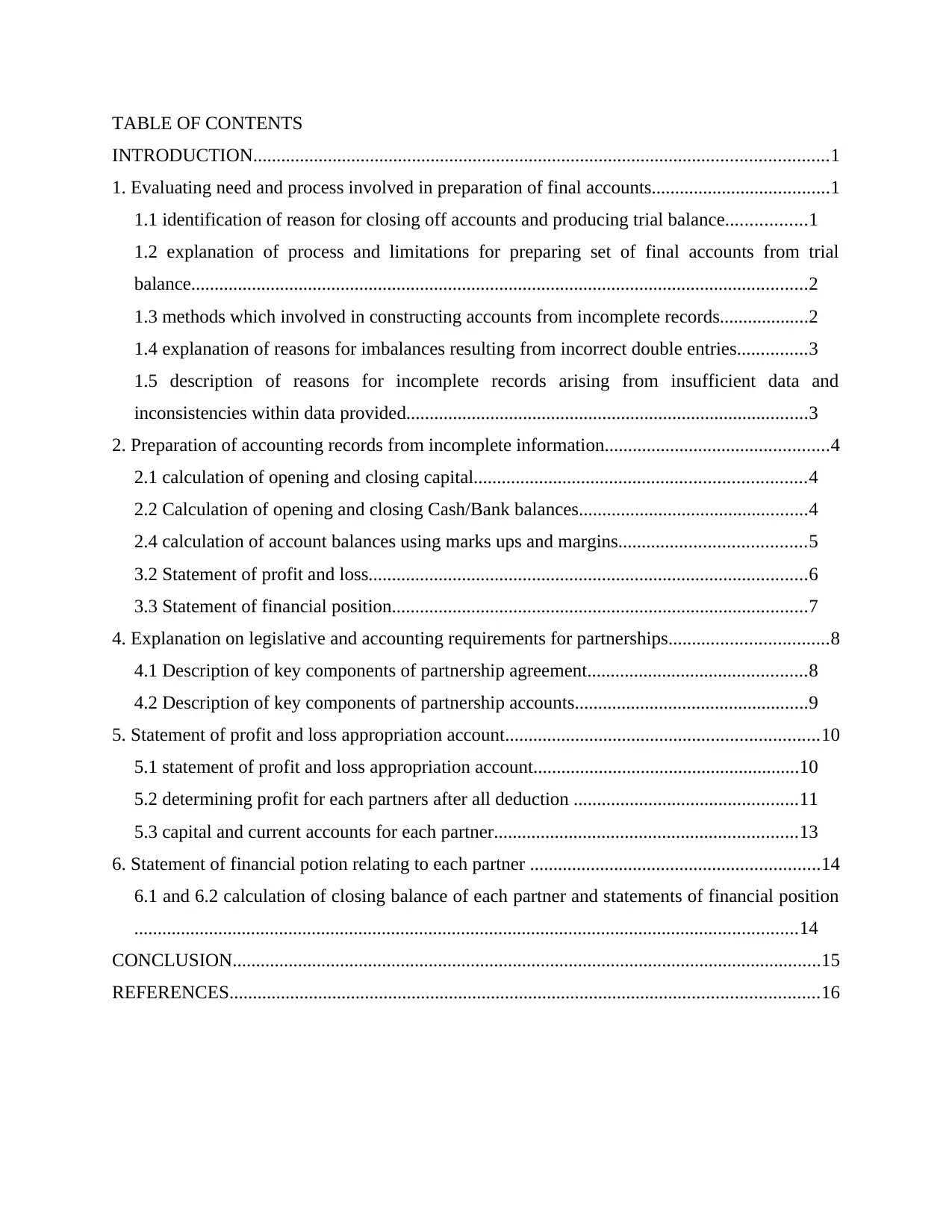
TABLE OF CONTENTS
INTRODUCTION...........................................................................................................................1
1. Evaluating need and process involved in preparation of final accounts......................................1
1.1 identification of reason for closing off accounts and producing trial balance.................1
1.2 explanation of process and limitations for preparing set of final accounts from trial
balance....................................................................................................................................2
1.3 methods which involved in constructing accounts from incomplete records...................2
1.4 explanation of reasons for imbalances resulting from incorrect double entries...............3
1.5 description of reasons for incomplete records arising from insufficient data and
inconsistencies within data provided......................................................................................3
2. Preparation of accounting records from incomplete information................................................4
2.1 calculation of opening and closing capital.......................................................................4
2.2 Calculation of opening and closing Cash/Bank balances.................................................4
2.4 calculation of account balances using marks ups and margins........................................5
3.2 Statement of profit and loss..............................................................................................6
3.3 Statement of financial position.........................................................................................7
4. Explanation on legislative and accounting requirements for partnerships..................................8
4.1 Description of key components of partnership agreement...............................................8
4.2 Description of key components of partnership accounts..................................................9
5. Statement of profit and loss appropriation account...................................................................10
5.1 statement of profit and loss appropriation account.........................................................10
5.2 determining profit for each partners after all deduction ................................................11
5.3 capital and current accounts for each partner.................................................................13
6. Statement of financial potion relating to each partner ..............................................................14
6.1 and 6.2 calculation of closing balance of each partner and statements of financial position
..............................................................................................................................................14
CONCLUSION..............................................................................................................................15
REFERENCES..............................................................................................................................16
INTRODUCTION...........................................................................................................................1
1. Evaluating need and process involved in preparation of final accounts......................................1
1.1 identification of reason for closing off accounts and producing trial balance.................1
1.2 explanation of process and limitations for preparing set of final accounts from trial
balance....................................................................................................................................2
1.3 methods which involved in constructing accounts from incomplete records...................2
1.4 explanation of reasons for imbalances resulting from incorrect double entries...............3
1.5 description of reasons for incomplete records arising from insufficient data and
inconsistencies within data provided......................................................................................3
2. Preparation of accounting records from incomplete information................................................4
2.1 calculation of opening and closing capital.......................................................................4
2.2 Calculation of opening and closing Cash/Bank balances.................................................4
2.4 calculation of account balances using marks ups and margins........................................5
3.2 Statement of profit and loss..............................................................................................6
3.3 Statement of financial position.........................................................................................7
4. Explanation on legislative and accounting requirements for partnerships..................................8
4.1 Description of key components of partnership agreement...............................................8
4.2 Description of key components of partnership accounts..................................................9
5. Statement of profit and loss appropriation account...................................................................10
5.1 statement of profit and loss appropriation account.........................................................10
5.2 determining profit for each partners after all deduction ................................................11
5.3 capital and current accounts for each partner.................................................................13
6. Statement of financial potion relating to each partner ..............................................................14
6.1 and 6.2 calculation of closing balance of each partner and statements of financial position
..............................................................................................................................................14
CONCLUSION..............................................................................................................................15
REFERENCES..............................................................................................................................16

⊘ This is a preview!⊘
Do you want full access?
Subscribe today to unlock all pages.

Trusted by 1+ million students worldwide
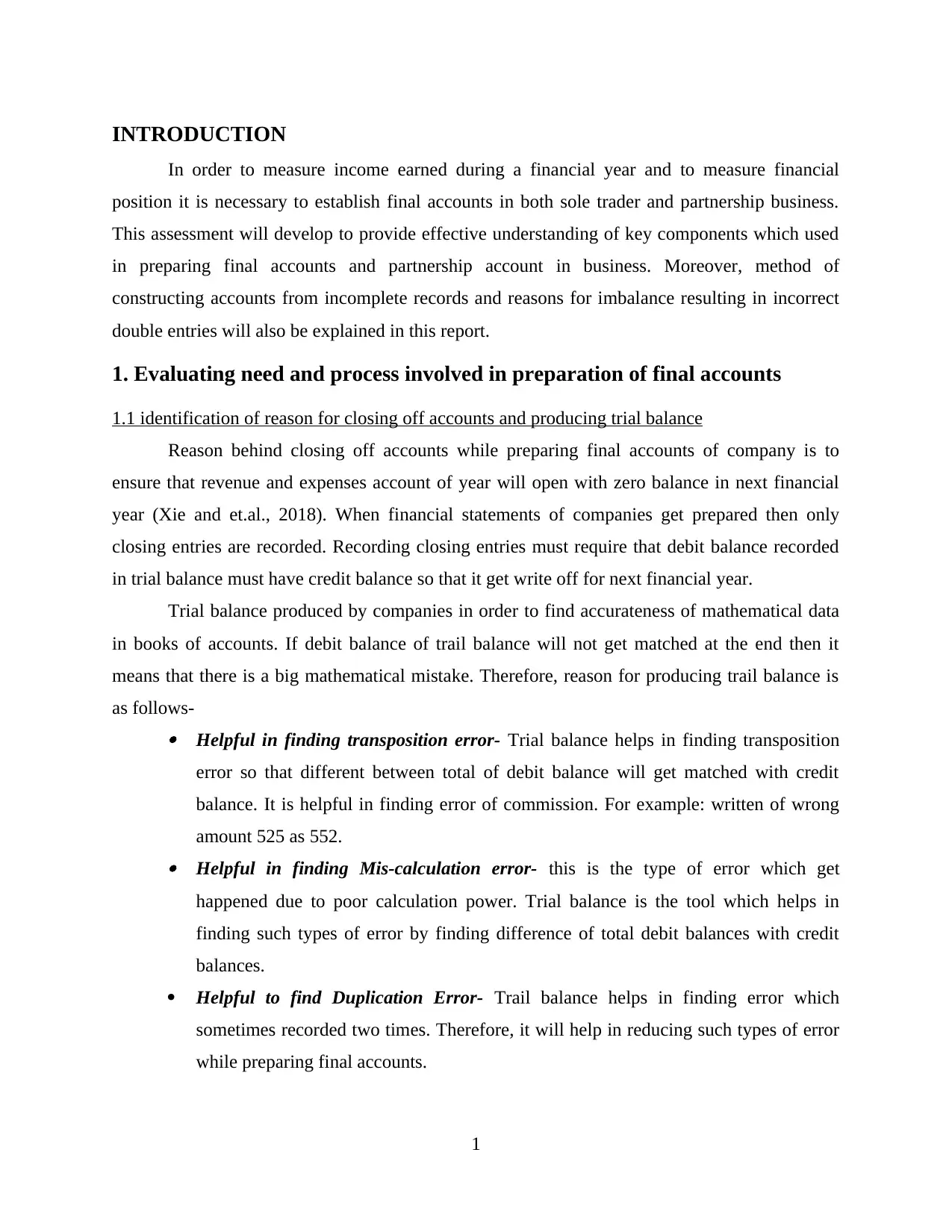
INTRODUCTION
In order to measure income earned during a financial year and to measure financial
position it is necessary to establish final accounts in both sole trader and partnership business.
This assessment will develop to provide effective understanding of key components which used
in preparing final accounts and partnership account in business. Moreover, method of
constructing accounts from incomplete records and reasons for imbalance resulting in incorrect
double entries will also be explained in this report.
1. Evaluating need and process involved in preparation of final accounts
1.1 identification of reason for closing off accounts and producing trial balance
Reason behind closing off accounts while preparing final accounts of company is to
ensure that revenue and expenses account of year will open with zero balance in next financial
year (Xie and et.al., 2018). When financial statements of companies get prepared then only
closing entries are recorded. Recording closing entries must require that debit balance recorded
in trial balance must have credit balance so that it get write off for next financial year.
Trial balance produced by companies in order to find accurateness of mathematical data
in books of accounts. If debit balance of trail balance will not get matched at the end then it
means that there is a big mathematical mistake. Therefore, reason for producing trail balance is
as follows-
Helpful in finding transposition error- Trial balance helps in finding transposition
error so that different between total of debit balance will get matched with credit
balance. It is helpful in finding error of commission. For example: written of wrong
amount 525 as 552.
Helpful in finding Mis-calculation error- this is the type of error which get
happened due to poor calculation power. Trial balance is the tool which helps in
finding such types of error by finding difference of total debit balances with credit
balances.
Helpful to find Duplication Error- Trail balance helps in finding error which
sometimes recorded two times. Therefore, it will help in reducing such types of error
while preparing final accounts.
1
In order to measure income earned during a financial year and to measure financial
position it is necessary to establish final accounts in both sole trader and partnership business.
This assessment will develop to provide effective understanding of key components which used
in preparing final accounts and partnership account in business. Moreover, method of
constructing accounts from incomplete records and reasons for imbalance resulting in incorrect
double entries will also be explained in this report.
1. Evaluating need and process involved in preparation of final accounts
1.1 identification of reason for closing off accounts and producing trial balance
Reason behind closing off accounts while preparing final accounts of company is to
ensure that revenue and expenses account of year will open with zero balance in next financial
year (Xie and et.al., 2018). When financial statements of companies get prepared then only
closing entries are recorded. Recording closing entries must require that debit balance recorded
in trial balance must have credit balance so that it get write off for next financial year.
Trial balance produced by companies in order to find accurateness of mathematical data
in books of accounts. If debit balance of trail balance will not get matched at the end then it
means that there is a big mathematical mistake. Therefore, reason for producing trail balance is
as follows-
Helpful in finding transposition error- Trial balance helps in finding transposition
error so that different between total of debit balance will get matched with credit
balance. It is helpful in finding error of commission. For example: written of wrong
amount 525 as 552.
Helpful in finding Mis-calculation error- this is the type of error which get
happened due to poor calculation power. Trial balance is the tool which helps in
finding such types of error by finding difference of total debit balances with credit
balances.
Helpful to find Duplication Error- Trail balance helps in finding error which
sometimes recorded two times. Therefore, it will help in reducing such types of error
while preparing final accounts.
1
Paraphrase This Document
Need a fresh take? Get an instant paraphrase of this document with our AI Paraphraser
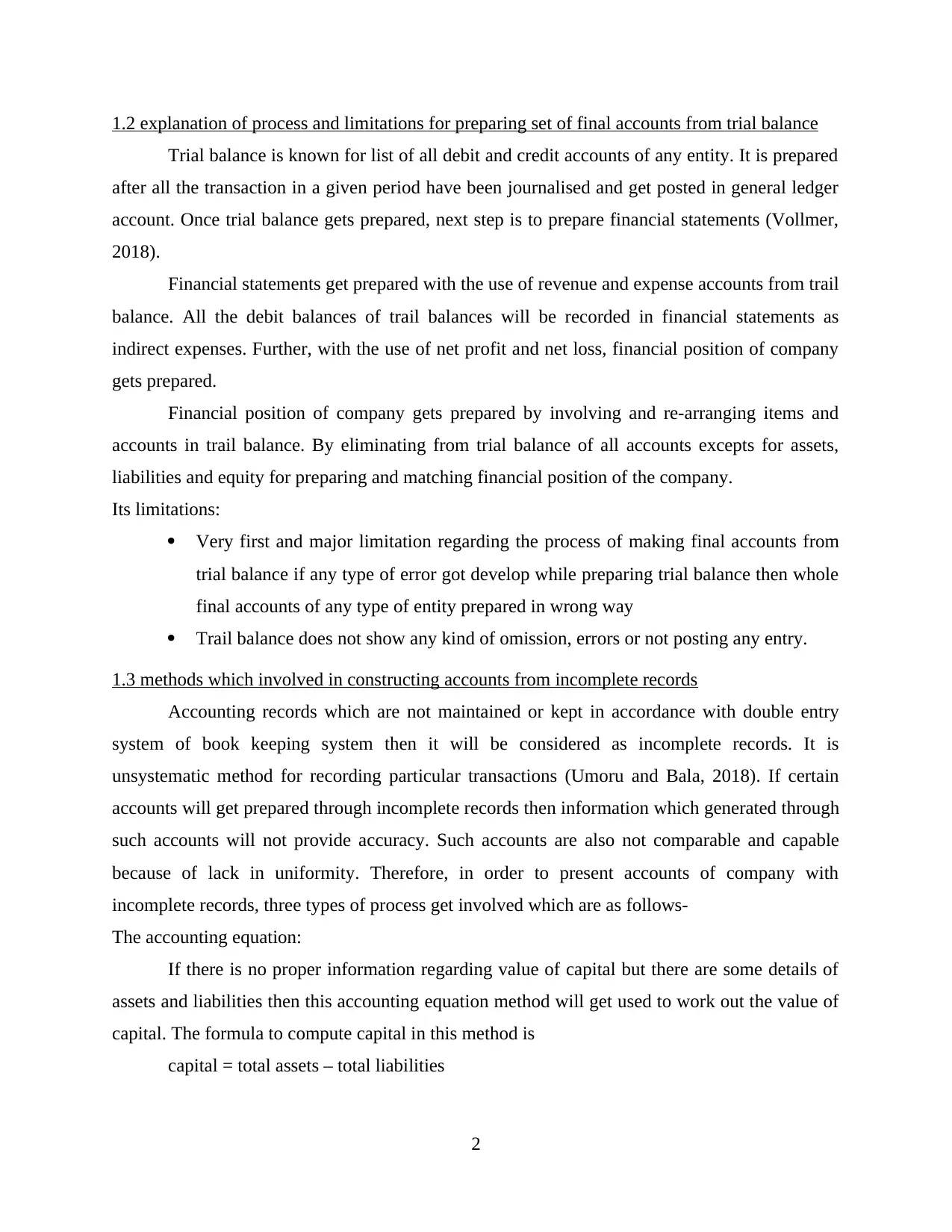
1.2 explanation of process and limitations for preparing set of final accounts from trial balance
Trial balance is known for list of all debit and credit accounts of any entity. It is prepared
after all the transaction in a given period have been journalised and get posted in general ledger
account. Once trial balance gets prepared, next step is to prepare financial statements (Vollmer,
2018).
Financial statements get prepared with the use of revenue and expense accounts from trail
balance. All the debit balances of trail balances will be recorded in financial statements as
indirect expenses. Further, with the use of net profit and net loss, financial position of company
gets prepared.
Financial position of company gets prepared by involving and re-arranging items and
accounts in trail balance. By eliminating from trial balance of all accounts excepts for assets,
liabilities and equity for preparing and matching financial position of the company.
Its limitations:
Very first and major limitation regarding the process of making final accounts from
trial balance if any type of error got develop while preparing trial balance then whole
final accounts of any type of entity prepared in wrong way
Trail balance does not show any kind of omission, errors or not posting any entry.
1.3 methods which involved in constructing accounts from incomplete records
Accounting records which are not maintained or kept in accordance with double entry
system of book keeping system then it will be considered as incomplete records. It is
unsystematic method for recording particular transactions (Umoru and Bala, 2018). If certain
accounts will get prepared through incomplete records then information which generated through
such accounts will not provide accuracy. Such accounts are also not comparable and capable
because of lack in uniformity. Therefore, in order to present accounts of company with
incomplete records, three types of process get involved which are as follows-
The accounting equation:
If there is no proper information regarding value of capital but there are some details of
assets and liabilities then this accounting equation method will get used to work out the value of
capital. The formula to compute capital in this method is
capital = total assets – total liabilities
2
Trial balance is known for list of all debit and credit accounts of any entity. It is prepared
after all the transaction in a given period have been journalised and get posted in general ledger
account. Once trial balance gets prepared, next step is to prepare financial statements (Vollmer,
2018).
Financial statements get prepared with the use of revenue and expense accounts from trail
balance. All the debit balances of trail balances will be recorded in financial statements as
indirect expenses. Further, with the use of net profit and net loss, financial position of company
gets prepared.
Financial position of company gets prepared by involving and re-arranging items and
accounts in trail balance. By eliminating from trial balance of all accounts excepts for assets,
liabilities and equity for preparing and matching financial position of the company.
Its limitations:
Very first and major limitation regarding the process of making final accounts from
trial balance if any type of error got develop while preparing trial balance then whole
final accounts of any type of entity prepared in wrong way
Trail balance does not show any kind of omission, errors or not posting any entry.
1.3 methods which involved in constructing accounts from incomplete records
Accounting records which are not maintained or kept in accordance with double entry
system of book keeping system then it will be considered as incomplete records. It is
unsystematic method for recording particular transactions (Umoru and Bala, 2018). If certain
accounts will get prepared through incomplete records then information which generated through
such accounts will not provide accuracy. Such accounts are also not comparable and capable
because of lack in uniformity. Therefore, in order to present accounts of company with
incomplete records, three types of process get involved which are as follows-
The accounting equation:
If there is no proper information regarding value of capital but there are some details of
assets and liabilities then this accounting equation method will get used to work out the value of
capital. The formula to compute capital in this method is
capital = total assets – total liabilities
2
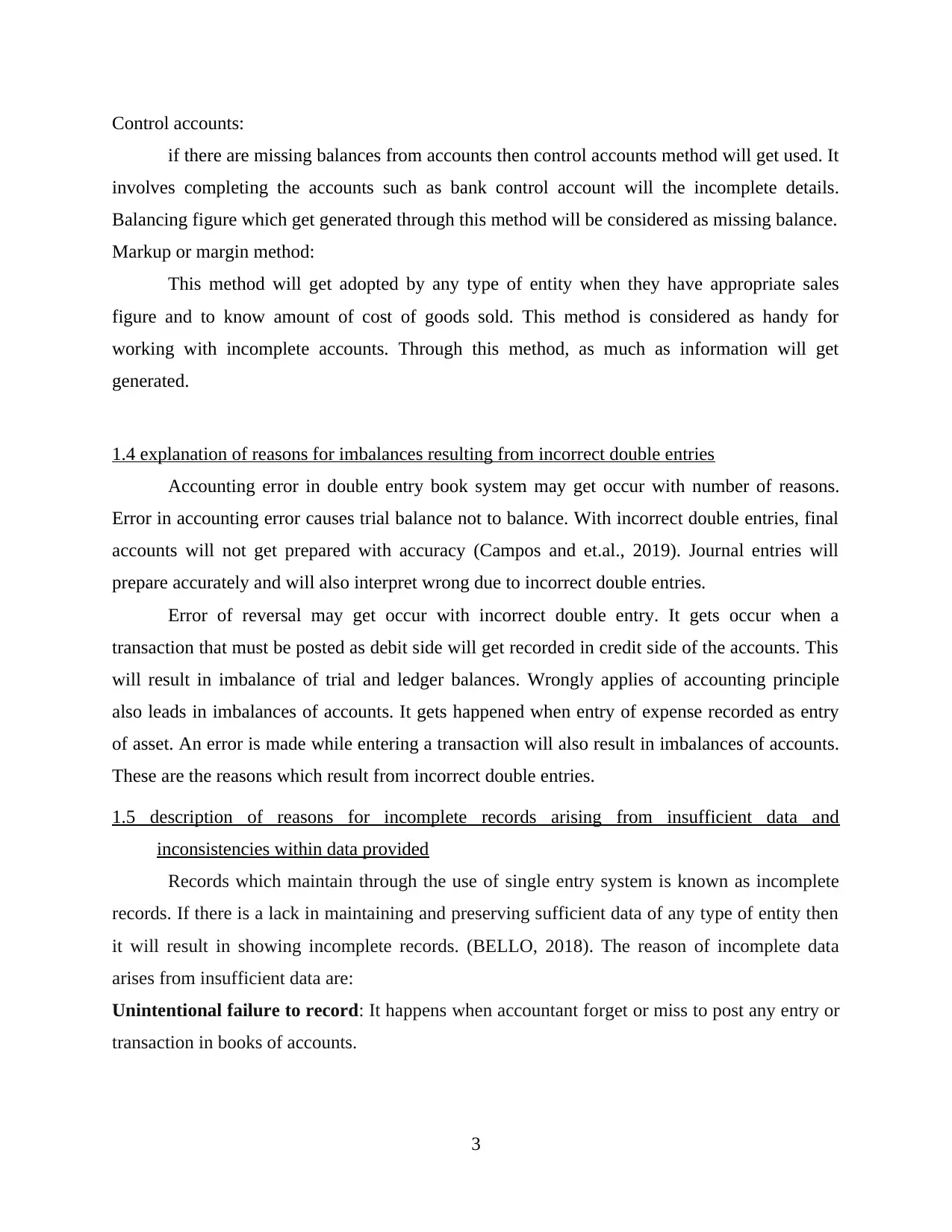
Control accounts:
if there are missing balances from accounts then control accounts method will get used. It
involves completing the accounts such as bank control account will the incomplete details.
Balancing figure which get generated through this method will be considered as missing balance.
Markup or margin method:
This method will get adopted by any type of entity when they have appropriate sales
figure and to know amount of cost of goods sold. This method is considered as handy for
working with incomplete accounts. Through this method, as much as information will get
generated.
1.4 explanation of reasons for imbalances resulting from incorrect double entries
Accounting error in double entry book system may get occur with number of reasons.
Error in accounting error causes trial balance not to balance. With incorrect double entries, final
accounts will not get prepared with accuracy (Campos and et.al., 2019). Journal entries will
prepare accurately and will also interpret wrong due to incorrect double entries.
Error of reversal may get occur with incorrect double entry. It gets occur when a
transaction that must be posted as debit side will get recorded in credit side of the accounts. This
will result in imbalance of trial and ledger balances. Wrongly applies of accounting principle
also leads in imbalances of accounts. It gets happened when entry of expense recorded as entry
of asset. An error is made while entering a transaction will also result in imbalances of accounts.
These are the reasons which result from incorrect double entries.
1.5 description of reasons for incomplete records arising from insufficient data and
inconsistencies within data provided
Records which maintain through the use of single entry system is known as incomplete
records. If there is a lack in maintaining and preserving sufficient data of any type of entity then
it will result in showing incomplete records. (BELLO, 2018). The reason of incomplete data
arises from insufficient data are:
Unintentional failure to record: It happens when accountant forget or miss to post any entry or
transaction in books of accounts.
3
if there are missing balances from accounts then control accounts method will get used. It
involves completing the accounts such as bank control account will the incomplete details.
Balancing figure which get generated through this method will be considered as missing balance.
Markup or margin method:
This method will get adopted by any type of entity when they have appropriate sales
figure and to know amount of cost of goods sold. This method is considered as handy for
working with incomplete accounts. Through this method, as much as information will get
generated.
1.4 explanation of reasons for imbalances resulting from incorrect double entries
Accounting error in double entry book system may get occur with number of reasons.
Error in accounting error causes trial balance not to balance. With incorrect double entries, final
accounts will not get prepared with accuracy (Campos and et.al., 2019). Journal entries will
prepare accurately and will also interpret wrong due to incorrect double entries.
Error of reversal may get occur with incorrect double entry. It gets occur when a
transaction that must be posted as debit side will get recorded in credit side of the accounts. This
will result in imbalance of trial and ledger balances. Wrongly applies of accounting principle
also leads in imbalances of accounts. It gets happened when entry of expense recorded as entry
of asset. An error is made while entering a transaction will also result in imbalances of accounts.
These are the reasons which result from incorrect double entries.
1.5 description of reasons for incomplete records arising from insufficient data and
inconsistencies within data provided
Records which maintain through the use of single entry system is known as incomplete
records. If there is a lack in maintaining and preserving sufficient data of any type of entity then
it will result in showing incomplete records. (BELLO, 2018). The reason of incomplete data
arises from insufficient data are:
Unintentional failure to record: It happens when accountant forget or miss to post any entry or
transaction in books of accounts.
3
⊘ This is a preview!⊘
Do you want full access?
Subscribe today to unlock all pages.

Trusted by 1+ million students worldwide
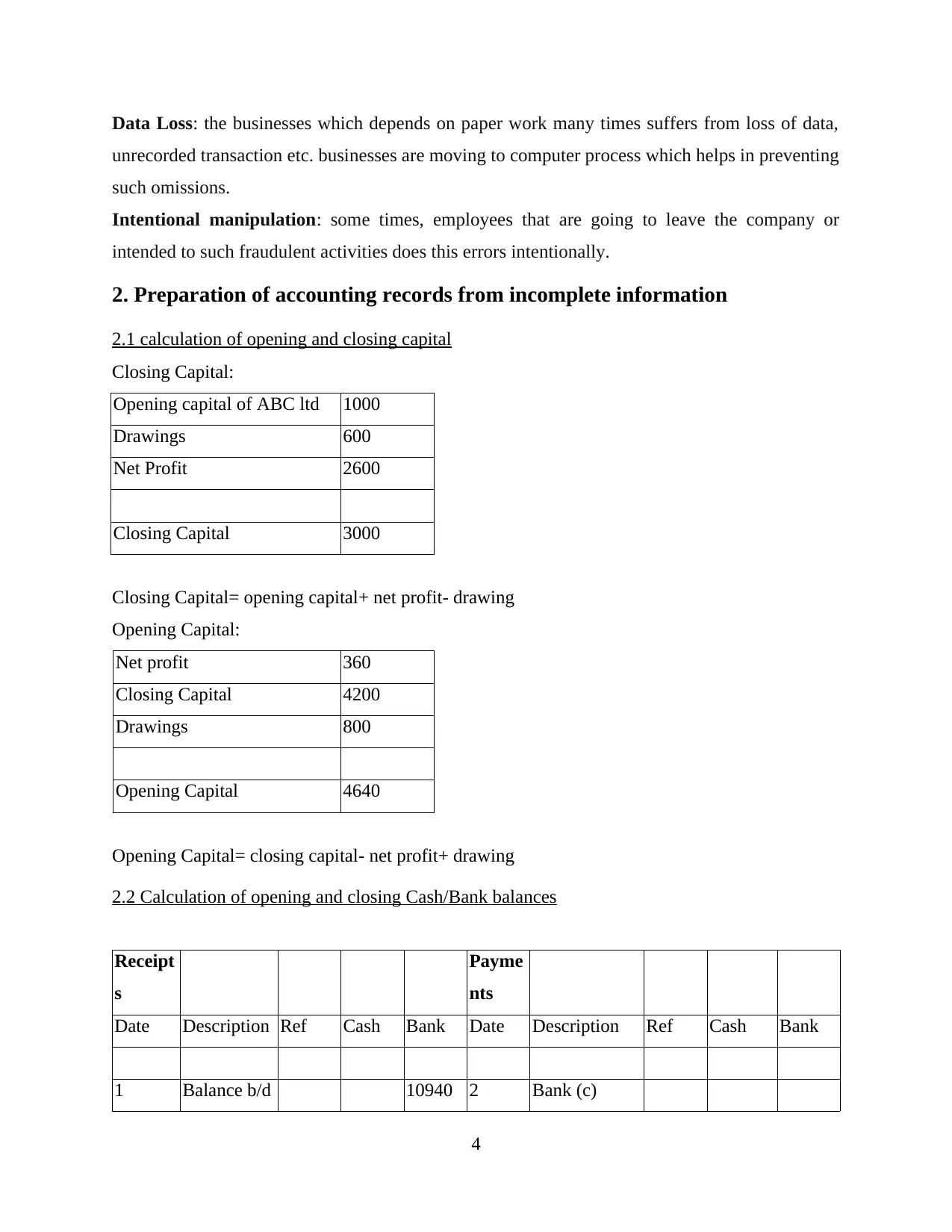
Data Loss: the businesses which depends on paper work many times suffers from loss of data,
unrecorded transaction etc. businesses are moving to computer process which helps in preventing
such omissions.
Intentional manipulation: some times, employees that are going to leave the company or
intended to such fraudulent activities does this errors intentionally.
2. Preparation of accounting records from incomplete information
2.1 calculation of opening and closing capital
Closing Capital:
Opening capital of ABC ltd 1000
Drawings 600
Net Profit 2600
Closing Capital 3000
Closing Capital= opening capital+ net profit- drawing
Opening Capital:
Net profit 360
Closing Capital 4200
Drawings 800
Opening Capital 4640
Opening Capital= closing capital- net profit+ drawing
2.2 Calculation of opening and closing Cash/Bank balances
Receipt
s
Payme
nts
Date Description Ref Cash Bank Date Description Ref Cash Bank
1 Balance b/d 10940 2 Bank (c)
4
unrecorded transaction etc. businesses are moving to computer process which helps in preventing
such omissions.
Intentional manipulation: some times, employees that are going to leave the company or
intended to such fraudulent activities does this errors intentionally.
2. Preparation of accounting records from incomplete information
2.1 calculation of opening and closing capital
Closing Capital:
Opening capital of ABC ltd 1000
Drawings 600
Net Profit 2600
Closing Capital 3000
Closing Capital= opening capital+ net profit- drawing
Opening Capital:
Net profit 360
Closing Capital 4200
Drawings 800
Opening Capital 4640
Opening Capital= closing capital- net profit+ drawing
2.2 Calculation of opening and closing Cash/Bank balances
Receipt
s
Payme
nts
Date Description Ref Cash Bank Date Description Ref Cash Bank
1 Balance b/d 10940 2 Bank (c)
4
Paraphrase This Document
Need a fresh take? Get an instant paraphrase of this document with our AI Paraphraser
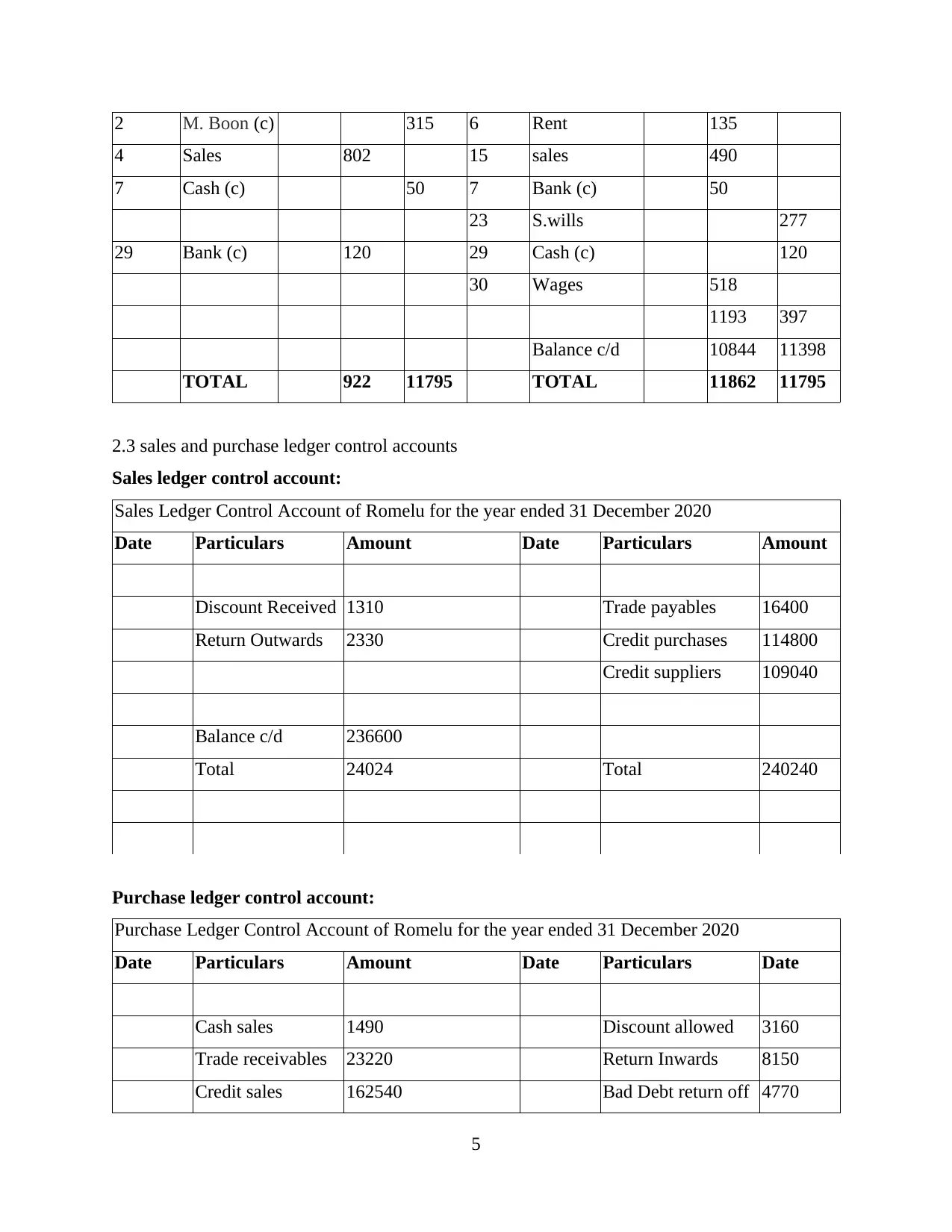
2 M. Boon (c) 315 6 Rent 135
4 Sales 802 15 sales 490
7 Cash (c) 50 7 Bank (c) 50
23 S.wills 277
29 Bank (c) 120 29 Cash (c) 120
30 Wages 518
1193 397
Balance c/d 10844 11398
TOTAL 922 11795 TOTAL 11862 11795
2.3 sales and purchase ledger control accounts
Sales ledger control account:
Sales Ledger Control Account of Romelu for the year ended 31 December 2020
Date Particulars Amount Date Particulars Amount
Discount Received 1310 Trade payables 16400
Return Outwards 2330 Credit purchases 114800
Credit suppliers 109040
Balance c/d 236600
Total 24024 Total 240240
Purchase ledger control account:
Purchase Ledger Control Account of Romelu for the year ended 31 December 2020
Date Particulars Amount Date Particulars Date
Cash sales 1490 Discount allowed 3160
Trade receivables 23220 Return Inwards 8150
Credit sales 162540 Bad Debt return off 4770
5
4 Sales 802 15 sales 490
7 Cash (c) 50 7 Bank (c) 50
23 S.wills 277
29 Bank (c) 120 29 Cash (c) 120
30 Wages 518
1193 397
Balance c/d 10844 11398
TOTAL 922 11795 TOTAL 11862 11795
2.3 sales and purchase ledger control accounts
Sales ledger control account:
Sales Ledger Control Account of Romelu for the year ended 31 December 2020
Date Particulars Amount Date Particulars Amount
Discount Received 1310 Trade payables 16400
Return Outwards 2330 Credit purchases 114800
Credit suppliers 109040
Balance c/d 236600
Total 24024 Total 240240
Purchase ledger control account:
Purchase Ledger Control Account of Romelu for the year ended 31 December 2020
Date Particulars Amount Date Particulars Date
Cash sales 1490 Discount allowed 3160
Trade receivables 23220 Return Inwards 8150
Credit sales 162540 Bad Debt return off 4770
5
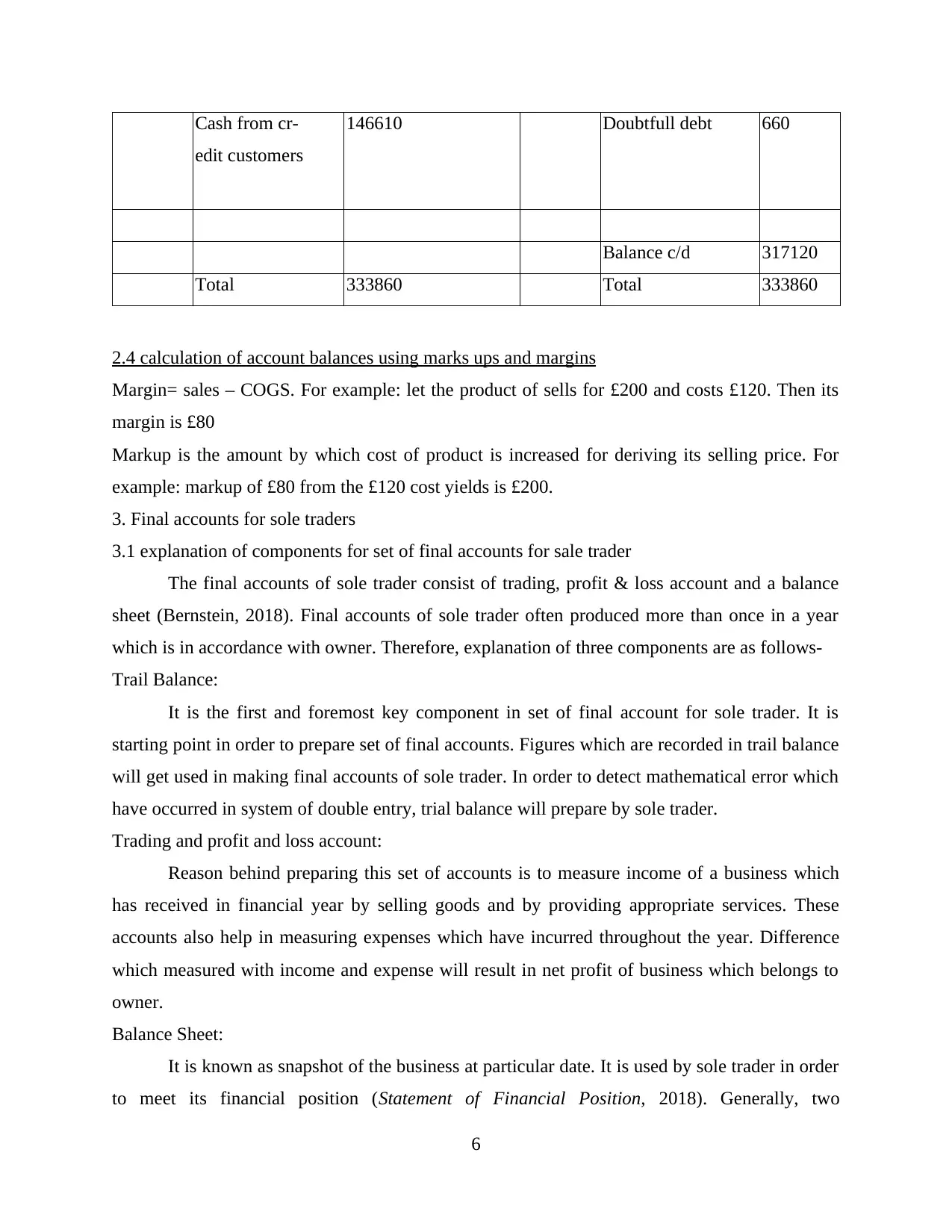
Cash from cr-
edit customers
146610 Doubtfull debt 660
Balance c/d 317120
Total 333860 Total 333860
2.4 calculation of account balances using marks ups and margins
Margin= sales – COGS. For example: let the product of sells for £200 and costs £120. Then its
margin is £80
Markup is the amount by which cost of product is increased for deriving its selling price. For
example: markup of £80 from the £120 cost yields is £200.
3. Final accounts for sole traders
3.1 explanation of components for set of final accounts for sale trader
The final accounts of sole trader consist of trading, profit & loss account and a balance
sheet (Bernstein, 2018). Final accounts of sole trader often produced more than once in a year
which is in accordance with owner. Therefore, explanation of three components are as follows-
Trail Balance:
It is the first and foremost key component in set of final account for sole trader. It is
starting point in order to prepare set of final accounts. Figures which are recorded in trail balance
will get used in making final accounts of sole trader. In order to detect mathematical error which
have occurred in system of double entry, trial balance will prepare by sole trader.
Trading and profit and loss account:
Reason behind preparing this set of accounts is to measure income of a business which
has received in financial year by selling goods and by providing appropriate services. These
accounts also help in measuring expenses which have incurred throughout the year. Difference
which measured with income and expense will result in net profit of business which belongs to
owner.
Balance Sheet:
It is known as snapshot of the business at particular date. It is used by sole trader in order
to meet its financial position (Statement of Financial Position, 2018). Generally, two
6
edit customers
146610 Doubtfull debt 660
Balance c/d 317120
Total 333860 Total 333860
2.4 calculation of account balances using marks ups and margins
Margin= sales – COGS. For example: let the product of sells for £200 and costs £120. Then its
margin is £80
Markup is the amount by which cost of product is increased for deriving its selling price. For
example: markup of £80 from the £120 cost yields is £200.
3. Final accounts for sole traders
3.1 explanation of components for set of final accounts for sale trader
The final accounts of sole trader consist of trading, profit & loss account and a balance
sheet (Bernstein, 2018). Final accounts of sole trader often produced more than once in a year
which is in accordance with owner. Therefore, explanation of three components are as follows-
Trail Balance:
It is the first and foremost key component in set of final account for sole trader. It is
starting point in order to prepare set of final accounts. Figures which are recorded in trail balance
will get used in making final accounts of sole trader. In order to detect mathematical error which
have occurred in system of double entry, trial balance will prepare by sole trader.
Trading and profit and loss account:
Reason behind preparing this set of accounts is to measure income of a business which
has received in financial year by selling goods and by providing appropriate services. These
accounts also help in measuring expenses which have incurred throughout the year. Difference
which measured with income and expense will result in net profit of business which belongs to
owner.
Balance Sheet:
It is known as snapshot of the business at particular date. It is used by sole trader in order
to meet its financial position (Statement of Financial Position, 2018). Generally, two
6
⊘ This is a preview!⊘
Do you want full access?
Subscribe today to unlock all pages.

Trusted by 1+ million students worldwide
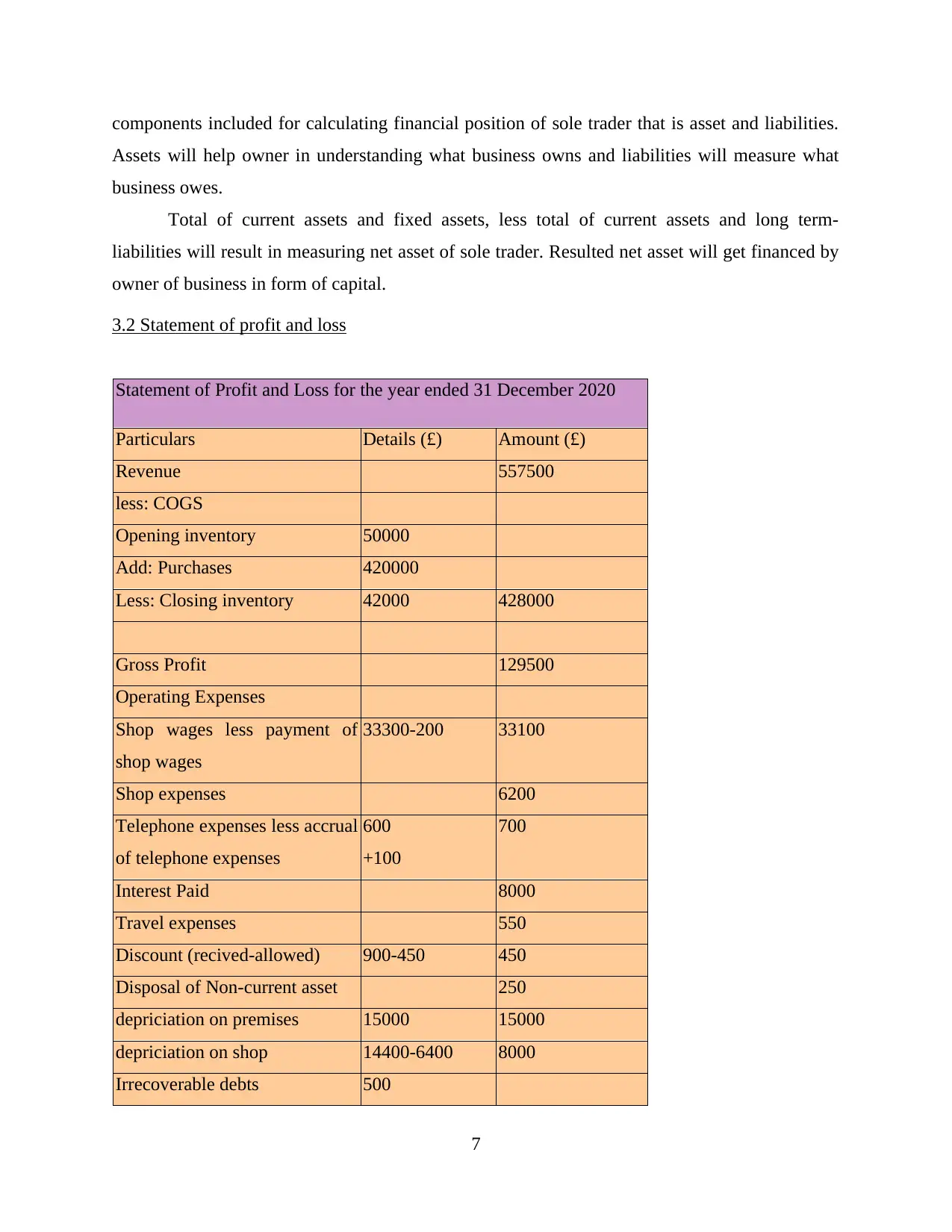
components included for calculating financial position of sole trader that is asset and liabilities.
Assets will help owner in understanding what business owns and liabilities will measure what
business owes.
Total of current assets and fixed assets, less total of current assets and long term-
liabilities will result in measuring net asset of sole trader. Resulted net asset will get financed by
owner of business in form of capital.
3.2 Statement of profit and loss
Statement of Profit and Loss for the year ended 31 December 2020
Particulars Details (£) Amount (£)
Revenue 557500
less: COGS
Opening inventory 50000
Add: Purchases 420000
Less: Closing inventory 42000 428000
Gross Profit 129500
Operating Expenses
Shop wages less payment of
shop wages
33300-200 33100
Shop expenses 6200
Telephone expenses less accrual
of telephone expenses
600
+100
700
Interest Paid 8000
Travel expenses 550
Discount (recived-allowed) 900-450 450
Disposal of Non-current asset 250
depriciation on premises 15000 15000
depriciation on shop 14400-6400 8000
Irrecoverable debts 500
7
Assets will help owner in understanding what business owns and liabilities will measure what
business owes.
Total of current assets and fixed assets, less total of current assets and long term-
liabilities will result in measuring net asset of sole trader. Resulted net asset will get financed by
owner of business in form of capital.
3.2 Statement of profit and loss
Statement of Profit and Loss for the year ended 31 December 2020
Particulars Details (£) Amount (£)
Revenue 557500
less: COGS
Opening inventory 50000
Add: Purchases 420000
Less: Closing inventory 42000 428000
Gross Profit 129500
Operating Expenses
Shop wages less payment of
shop wages
33300-200 33100
Shop expenses 6200
Telephone expenses less accrual
of telephone expenses
600
+100
700
Interest Paid 8000
Travel expenses 550
Discount (recived-allowed) 900-450 450
Disposal of Non-current asset 250
depriciation on premises 15000 15000
depriciation on shop 14400-6400 8000
Irrecoverable debts 500
7
Paraphrase This Document
Need a fresh take? Get an instant paraphrase of this document with our AI Paraphraser
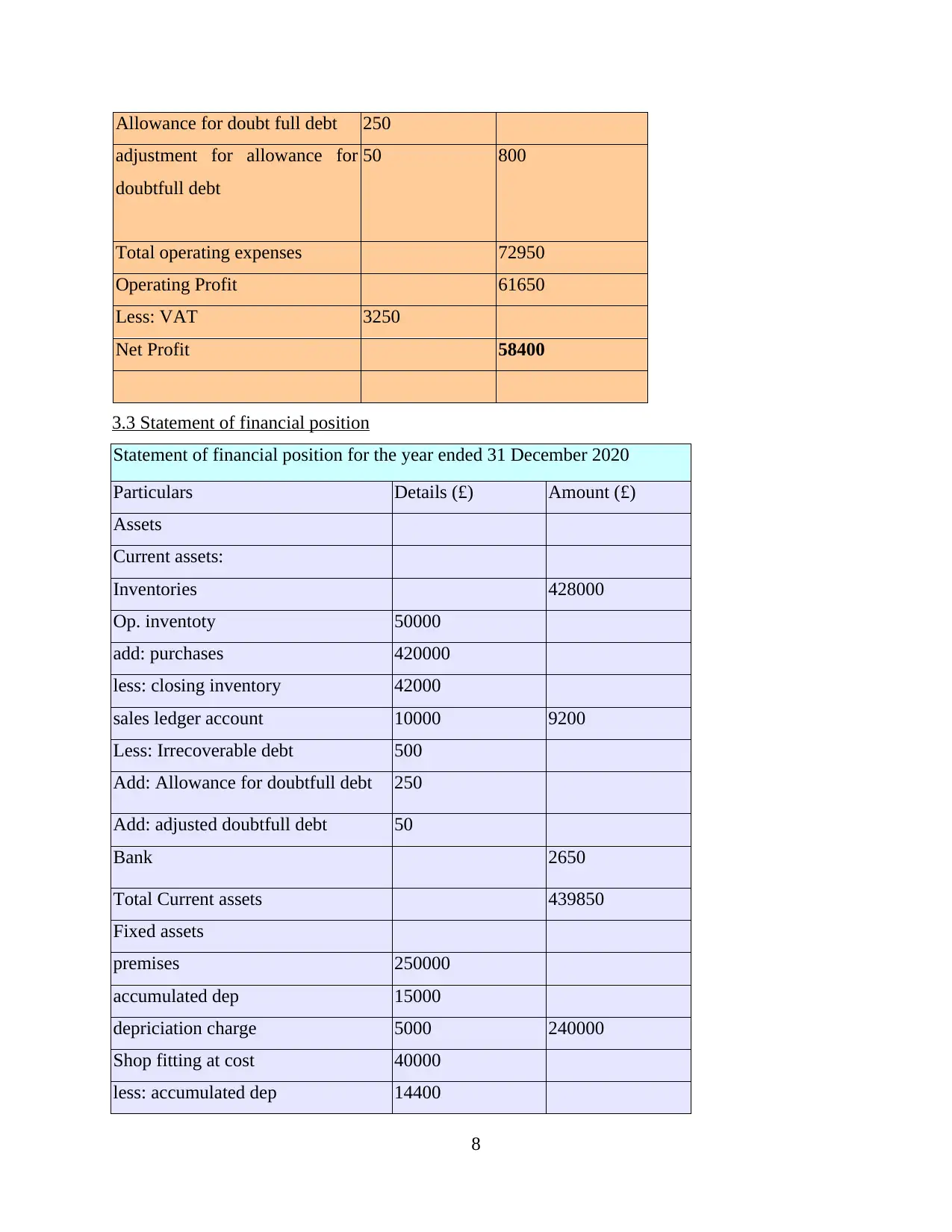
Allowance for doubt full debt 250
adjustment for allowance for
doubtfull debt
50 800
Total operating expenses 72950
Operating Profit 61650
Less: VAT 3250
Net Profit 58400
3.3 Statement of financial position
Statement of financial position for the year ended 31 December 2020
Particulars Details (£) Amount (£)
Assets
Current assets:
Inventories 428000
Op. inventoty 50000
add: purchases 420000
less: closing inventory 42000
sales ledger account 10000 9200
Less: Irrecoverable debt 500
Add: Allowance for doubtfull debt 250
Add: adjusted doubtfull debt 50
Bank 2650
Total Current assets 439850
Fixed assets
premises 250000
accumulated dep 15000
depriciation charge 5000 240000
Shop fitting at cost 40000
less: accumulated dep 14400
8
adjustment for allowance for
doubtfull debt
50 800
Total operating expenses 72950
Operating Profit 61650
Less: VAT 3250
Net Profit 58400
3.3 Statement of financial position
Statement of financial position for the year ended 31 December 2020
Particulars Details (£) Amount (£)
Assets
Current assets:
Inventories 428000
Op. inventoty 50000
add: purchases 420000
less: closing inventory 42000
sales ledger account 10000 9200
Less: Irrecoverable debt 500
Add: Allowance for doubtfull debt 250
Add: adjusted doubtfull debt 50
Bank 2650
Total Current assets 439850
Fixed assets
premises 250000
accumulated dep 15000
depriciation charge 5000 240000
Shop fitting at cost 40000
less: accumulated dep 14400
8
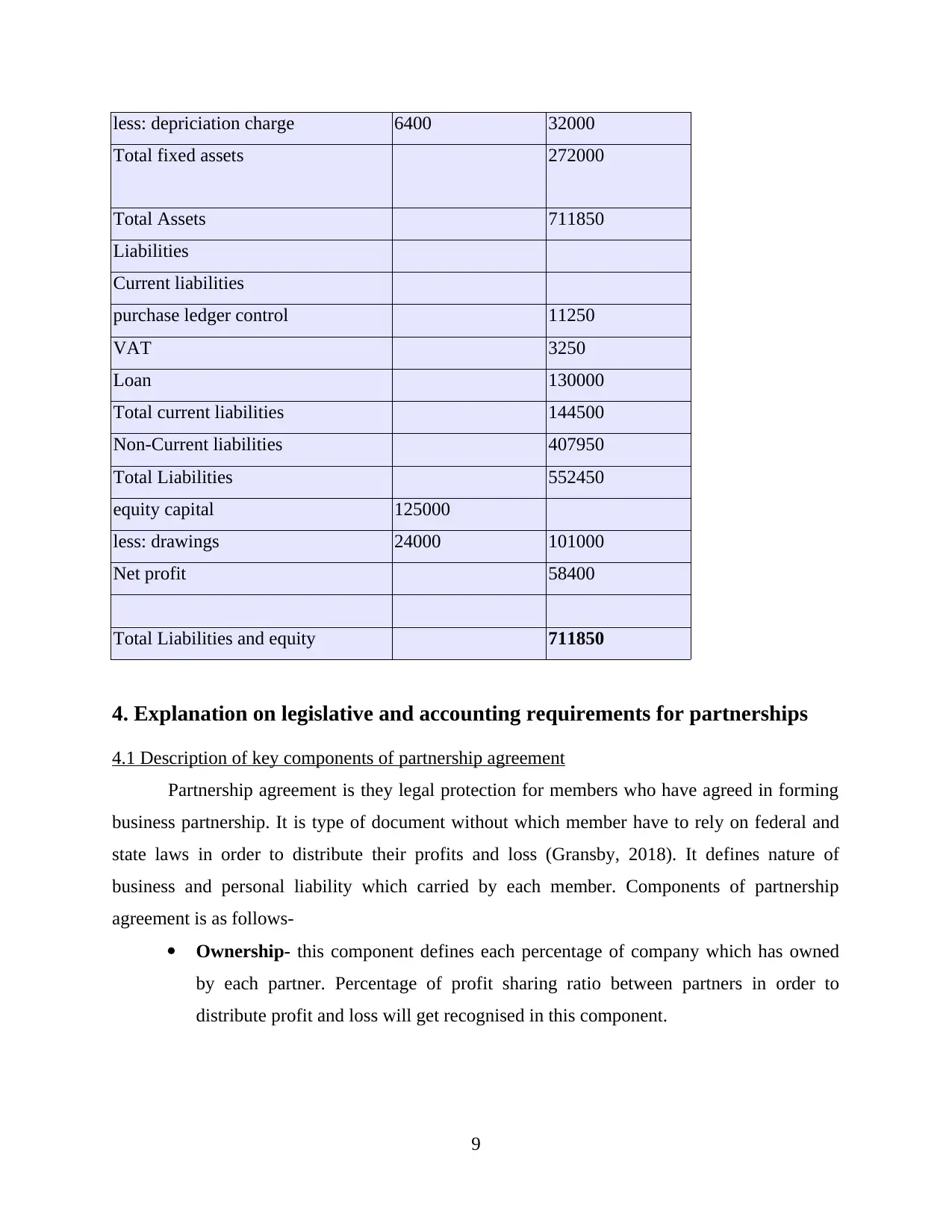
less: depriciation charge 6400 32000
Total fixed assets 272000
Total Assets 711850
Liabilities
Current liabilities
purchase ledger control 11250
VAT 3250
Loan 130000
Total current liabilities 144500
Non-Current liabilities 407950
Total Liabilities 552450
equity capital 125000
less: drawings 24000 101000
Net profit 58400
Total Liabilities and equity 711850
4. Explanation on legislative and accounting requirements for partnerships
4.1 Description of key components of partnership agreement
Partnership agreement is they legal protection for members who have agreed in forming
business partnership. It is type of document without which member have to rely on federal and
state laws in order to distribute their profits and loss (Gransby, 2018). It defines nature of
business and personal liability which carried by each member. Components of partnership
agreement is as follows-
Ownership- this component defines each percentage of company which has owned
by each partner. Percentage of profit sharing ratio between partners in order to
distribute profit and loss will get recognised in this component.
9
Total fixed assets 272000
Total Assets 711850
Liabilities
Current liabilities
purchase ledger control 11250
VAT 3250
Loan 130000
Total current liabilities 144500
Non-Current liabilities 407950
Total Liabilities 552450
equity capital 125000
less: drawings 24000 101000
Net profit 58400
Total Liabilities and equity 711850
4. Explanation on legislative and accounting requirements for partnerships
4.1 Description of key components of partnership agreement
Partnership agreement is they legal protection for members who have agreed in forming
business partnership. It is type of document without which member have to rely on federal and
state laws in order to distribute their profits and loss (Gransby, 2018). It defines nature of
business and personal liability which carried by each member. Components of partnership
agreement is as follows-
Ownership- this component defines each percentage of company which has owned
by each partner. Percentage of profit sharing ratio between partners in order to
distribute profit and loss will get recognised in this component.
9
⊘ This is a preview!⊘
Do you want full access?
Subscribe today to unlock all pages.

Trusted by 1+ million students worldwide
1 out of 19
Related Documents
Your All-in-One AI-Powered Toolkit for Academic Success.
+13062052269
info@desklib.com
Available 24*7 on WhatsApp / Email
![[object Object]](/_next/static/media/star-bottom.7253800d.svg)
Unlock your academic potential
Copyright © 2020–2025 A2Z Services. All Rights Reserved. Developed and managed by ZUCOL.





